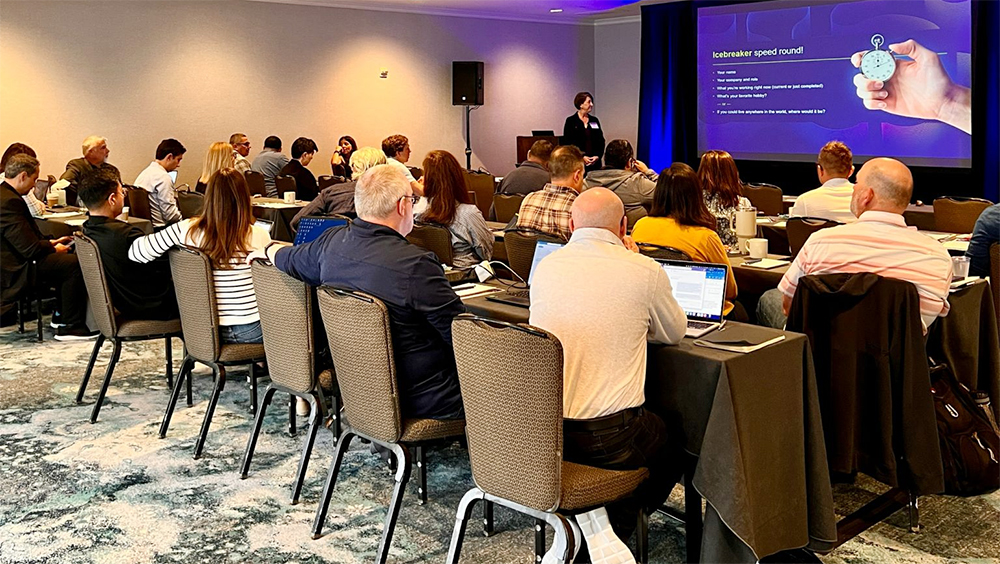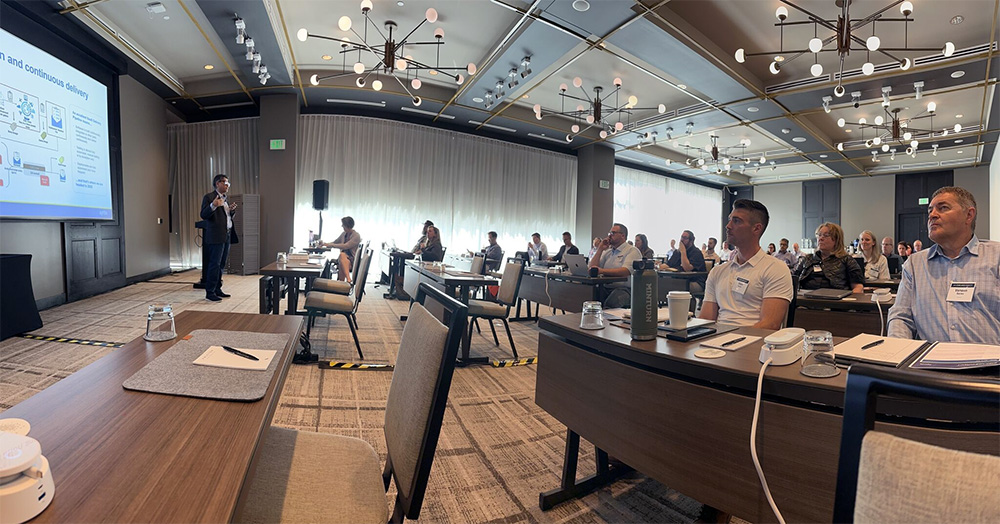
MDM, RFID, EAS, AI and OMS: The alphabet soup of retailers’ hot topics
One look at today’s retail headlines will tell you just how many issues retailers have to face every day. The list of issues is long and constantly changing, which is, of course, difficult for retailers to stay on top of, but it is also difficult for technology vendors to identify the issues that retailers consider a priority.
All of this makes any event where retailers gather an opportunity to listen, to hear where they are investing their energy and their resources, to learn what keeps them awake at night and to better understand where they see opportunities ahead.
We had just such an opportunity to listen when we recently hosted Engage Direct, our annual user conference. This year we hosted our retail clients at a series of events in New York, Newport Beach and Denver. More than 60 retailers attended the three events, and the agenda was designed to encourage attendees to share their concerns, successes, challenges and aspirations. And share they did – particularly when it came to discussing their priority issues (and opportunities) in the stores. The store continues to be the heartbeat of their business, and store technology continues to occupy a significant portion of their attention and investments.

The issues that they told us are top of mind right now are a veritable alphabet soup of technologies, challenges and capabilities centered on the customer and associate experiences in the store:
MDM (Mobile Device Management)
The retailers attending Engage Direct were passionate about the value and benefits of mobile point of sale. There was far less consensus, however, about the best ways to leverage MDM technology to help them manage all those mobile devices scattered across their estates.
When implemented well, MDM helps protect mobile devices from malware and other nefarious activities while also providing user authentication, data encryption, password enforcement and even remote lock and wipe features in case devices are lost or stolen.
While there is a plethora of MDM tools to help retailers capture those benefits, most come with a few drawbacks and a wide range of price points. All of which has our event attendees searching for guidance and clarity on how to select technology to optimize this emerging – and rapidly growing – challenge in their increasingly mobile stores.
One of the big issues many attendees described is the challenge they face managing multiple mobile device types. Their stores typically use devices built upon a variety of operating systems (iOS, Android, Windows), often on different versions of those operating systems which creates a complex management environment. Varying limitations in hardware capabilities across device type and versions and operating systems further complicates things, making device management and policy enforcement challenging.
Some retailers have resorted to implementing multiple MDM solutions to manage those different device types, but that, of course, makes it difficult to develop one single view of all the mobile devices in their estates. As a result, their ability to monitor, analyze and react to conditions in their stores is delayed and compromised, at best. They are seeking reliable one-size-fits-all MDM solutions and they are having trouble with that search.
Event attendees agreed that it’s time to make MDM technology optimization as much of a priority as moving more store capabilities to those mobile devices.

RFID (Radio Frequency Identification)
Yes, believe it or not, RFID is still (again?) a hot topic. During the event, Aptos personnel presented six use cases for RFID, and we asked attendees to comment on the urgency/priority of each use case inside their stores:
- Optimizing inventory receiving
- Tracking inventory movement from back room to sales floor
- Counting physical inventory
- Aiding omnichannel order fulfillment processes
- Automating product scanning at POS
- Streamlining electronic article surveillance (EAS)
Perhaps unsurprisingly (most attendees at our events do not operate big box stores), they had very little interest in or urgency to use RFID to help track inventory as it moves between the back room and the sales floor.
They did (still) have interest in and some sense of urgency to explore further how RFID could be used to improve/optimize their inventory management and fulfillment processes, but these were not the use cases of most interest and urgency to our audience.
Of the six RFID use cases we presented, scanning products at the POS and streamlining EAS were far and away of most interest to Engage Direct attendees. Retailers we spoke with are intrigued by the potential of RFID to help build carts and – here’s the kicker – automatically deactivate the EAS tags at the same time. They see real opportunities to reduce some of the friction from the customer experience and lower the costs of implementing EAS at the same time, one of those rare win-win scenarios that tend to motivate investment.
Hence, and yes, I realize this has been said many times for many years, but if our attendees’ interests are any indicator, RFID (at POS anyway) may indeed be a space to watch. Again.

AI (Artificial Intelligence)
It seems that no discussion of hot topics these days would be complete without a conversation about AI, and Engage Direct was certainly no exception. The range of AI issues mentioned by attendees was wide, but the most urgency (and passion) was reserved for two issues:
- They are struggling with the current state of their data. (“Our data is crap!” may or may not have been shouted from the back row by one particularly exasperated attendee.) They simply don’t trust the quality of the data that AI requires to ensure accuracy, consistency and reliability in AI models and forecasts. Dirty or inaccurate data can lead to flawed conclusions, reduced trust in AI outputs and even biased results. And clearly, our Engage Direct attendees know they need to invest in cleaning up their data.
- They want AI embedded in the applications that drive their business. They have no interest in going at it alone and investing in stand-alone AI platforms or foundational models that leverage the inputs and data from business applications.
AI is clearly and firmly a top-of-mind issue for the retailers we spoke with, and getting their data ready for the next wave of embedded AI capabilities to arrive is an urgent priority.
OMS (Order Management System)
As the role of the store in the omnichannel journey continues to expand, “mixed-cart” transactions – transactions that include activities originating in multiple channels – are becoming more and more common. Delivering seamless mixed-cart transactions in the store requires lots of integration and process coordination, much of which has been the subject of heavy discussion in retail as of late.
So we were not surprised when our attendees raised the topic during Engage Direct. But we were surprised when the specific issue they wanted to discuss was “pre-auth” (pre-authorization hold on a credit card), of all things. Pre-auth is not a new concept by any means, and it’s one that most people – retailers and consumers alike – take for granted. Or so we thought.
The issue attendees brought up was how to best deal with mixed-cart orders placed in the store when one of the items purchased is not in the store and requires shipment from another location at a later date. Retailers expressed concerns about when to pre-authorize the item still to be shipped. Today they typically do so at the time of purchase in the store. They simply authorize the entire purchase, inclusive of both the cash-and-carry items as well as the items to be shipped from elsewhere.
Technically, they should only authorize the cash-and-carry items at the point of sale and then have the OMS authorize the to-be-shipped items when they are actually shipped. However, retailers told us customers typically don’t like the multiple charges appearing on their credit card. The multiple charges for one transaction can be confusing and can lead to customer service challenges for their stores. Splitting the authorizations leads to more complexity for the retailers too, including more complex workflows and processes, with more opportunities for mistakes.
But authorizing all at once can also bring challenges. For one, in some areas, it could be out of compliance with laws governing such processes. Additionally, for items with longer shipping lead times, pre-authorizations can expire, which brings another set of challenges and complexities.
This is a seemingly small issue but one fraught with not-so-small complexity and one likely to grow in frequency as mixed-cart transactions become more and more common.
There were of course many other issues discussed during the three Engage Direct events, but this collection of acronyms formed the basis of the alphabet soup of hot topics and priority issues. We greatly appreciated the chance to hear directly from retailers and understand their perspectives on these key topics.


